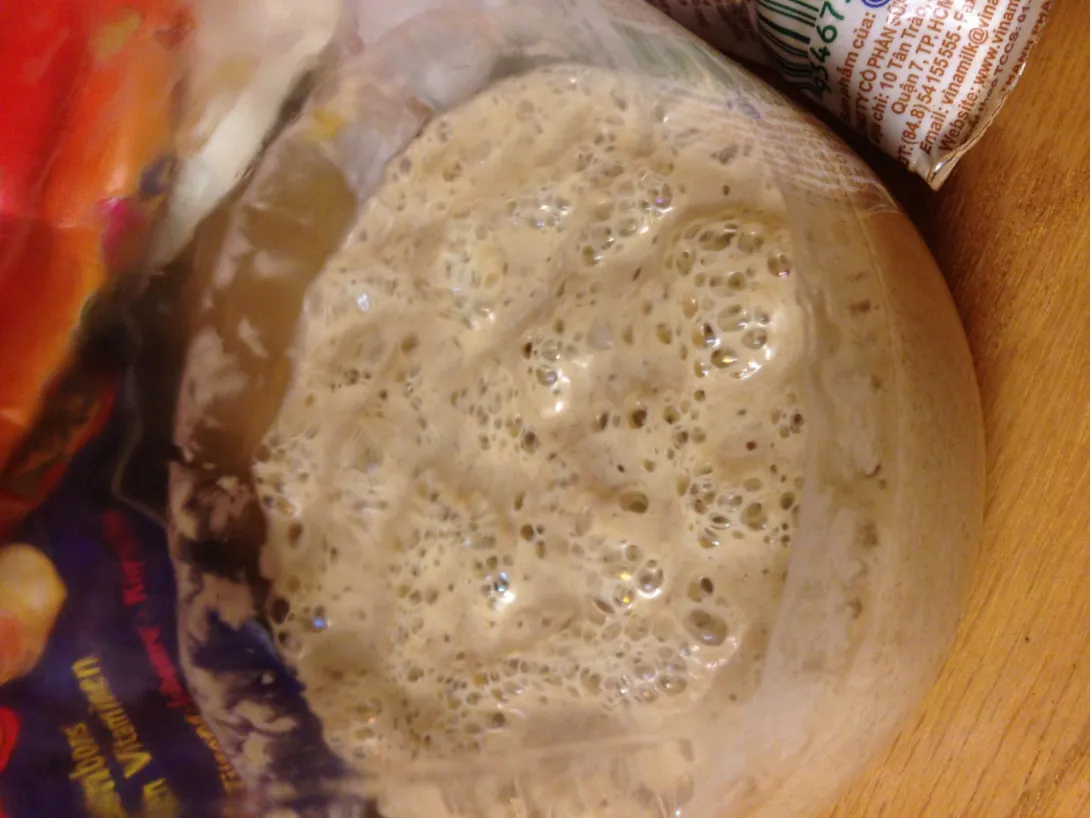
Hi everyone,
Recently I've been up to the challenge of making my own wild yeast starter by mixing pineapple juice with rye flour. I followed a simple recipe that calls for 2Tbs of juice and flour everyday for 4 days and feed normally thereupon. Its been day 3 now and the yeast is extremely bubbly after only 8 hours from the last feed while the recipe suggested 12 hrs or so. I've read that the yeast being active is a good sign but I'm also worried that i might be doing sth wrong because this is my first time catching yeast therefore i should be following the recipe exactly. Should i feed it twice? Should i double the flour? Should i start feeding it white flour and water? any suggestion is welcomed. Thanks guys.
Trang
PS the room temp is about 30C or so.
in the process. Does it smell beery and/or yeasty? If so, double or increase the flour. Take out a Tbs of starter after the bubbles seem to be decreasing and feed one spoon each rye and wheat with enough water to keep it a soft paste. Try putting it into a narrow straight glass to watch the activity. Note when it rises and peaks and starts to fall back. When it starts to fall back remove a portion to feed and watch it again. If the feeding is kept constant you should see improvement with each feeding.
You may see a drop in activity when adding wheat and also switching to water if the juice is sweetened. But with a little more time, it will so be back on track rising. Let the starter tell you when you should feed it. It will smell yeasty and taste sour and discolour slightly
It smells yeasty indeed. In fact, I really like the smell, sweetly alcoholic with a hint of pineapple. But anyway, I thought the initial feedings doesn't have to be extracting portions and replacing new food as this step is saved for day 4 and so on but who knows? Maybe the yeast matures a little sooner. I followed your instruction immediately after judging the rise and fall of the yeast and hope that it will slow down a bit.
One more thing I'm still wondering is the sugar content in the juice. Like you said, if the juice is sweetened then there might be a drop of activity when switching to wheat and water but what about unsweetened juice (juice that is naturally sweetened)? What difference in reaction there is between sucrose and fructose if discreetly added into the yeast? Maybe the yeast likes fructose better? Thanks.
Btw, I'm using juice from fresh bought pineapple.
Trang
I just recently started a starter with rye and pineapple juice using Debra Wink's pineapple juice solution. In her excellent post, she mentions that it is the acidic environment that wakes up the dormant yeast, so it is entirely possible that you would see activity even on the first day! In my case, that didn't happen, but whenever it becomes active and smells yeasty it is ready for regular feedings, whatever the day is. I've not been tracking my room temps, but with warmer weather, my house does get a little warmer, even with A/C running. I must feed my new starter 1:4:4 in order to keep it from reaching peak well before 12 hours. In fact, last night at about 9PM, I fed 30g starter with 100g each of AP flour and bottled water, and it had reached peak and begun to fall before 4:30AM this morning. That is only 7.5 hours! Silly me, thinking it could get by with less food overnight! I lowered the inoculation to 20g starter this morning and fed it 100g each of AP and water. Hopefully, with the feeding at 1:5:5, it will be hungry, but not too hungry, by the time I get back to it this evening. It will have been over 12 hours by then. So, there is nothing wrong with your starter being very active. In fact, the more active, the better. Your waiting times while making bread will be shorter!
As for the difference in sucrose versus fructose, I'm not sure there will be any noticeable difference in your starter activity from one sugar to the other. Both are used effectively to boost growth. But neither is needed, because the yeast and LABs can break down the starches in the flour to get all the food they need. Sugar to them is the same as it is to us humans: cheap energy.
Thanks for saving my time with your summary on the link's long explanation, but I'm definitely gonna check it for more info. Guess I'll be feeding it more flour in this kind of weather.
Btw, love your definition of sugar - cheap energy. Wonder if yeast can get fat with sugars like human. :))
Trang